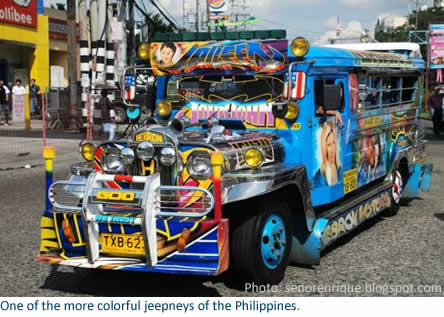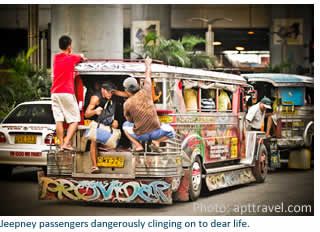|

 rom
its inception, the Philippine jeepney has been a symbol of Pinoy
ingenuity. In the war-ravaged streets of newly liberated Manila in 1945,
Filipinos were faced with huge public transportation problem. The tram
system (tranvia) that used to serve major thoroughfares of the city was
completely destroyed; its metal rails uprooted, and the overhead
electric cables gone. It was going to take years to put the entire
system back in place. However, quick-thinking Pinoys saw that the city
had a surplus of U.S. Army jeeps. There were so many jeeps in fact that
the Army actually began burying a few just to get rid of them. rom
its inception, the Philippine jeepney has been a symbol of Pinoy
ingenuity. In the war-ravaged streets of newly liberated Manila in 1945,
Filipinos were faced with huge public transportation problem. The tram
system (tranvia) that used to serve major thoroughfares of the city was
completely destroyed; its metal rails uprooted, and the overhead
electric cables gone. It was going to take years to put the entire
system back in place. However, quick-thinking Pinoys saw that the city
had a surplus of U.S. Army jeeps. There were so many jeeps in fact that
the Army actually began burying a few just to get rid of them.
That was all the
encouragement resourceful Manilenos needed to create the unique Filipino
invention we know as the jeepney. At the time, there was no shortage of
military jeeps so jeepneys began sprouting everywhere ... transportation
problem solved!
For those came up with
the idea, the jeepney was simply a stop-gap measure to get Filipinos
around the war-ravaged streets of Manila. It was never intended to be a
permanent fixture of Philippine public transportation.
The jeepney's garish
colors and kitsch decor make it a sight to behold. Blinking colored
lights, loud music, and fancy car horn just adds to its pizzaz.
For Filipinos, the
ubiquitous jeepney is probably the cheapest way to get around. But like
all things in this world, we believe the era of the jeepney
unfortunately, must come to an end.
Why the jeepney must
go
For starters, according
to Wikipedia "A recent study published in a Metro Manila newspaper
compared the fuel use of a 16-passenger jeepney to a 54-passenger
air-conditioned bus and found that the fuel consumption for both was the
same." So assuming that the study is accurate, it would take 3.375
jeepneys to move all 54 passengers of one bus. And if the fuel
consumption of the Jeepney and the bus are the same as Wikipedia also
notes, then a city with jeepneys uses three times as much fuel to move
people, than it would if it relied only on buses. That is one reason
why when you go to any developed country in the world, you see buses or
trams moving commuters around.
Secondly, jeepneys
exacerbate the problem of overcrowded city streets. You need more of
them to carry commuters around. Jeepneys can block traffic as they wait
to fill up with passengers. Jeepney drivers weave in and out of traffic
as they try overtake other jeepneys in order to be the first to reach
waiting passengers up ahead. The cost of scrapes and dings on a jeepney
are negligible and their drivers use that fact to cut off other vehicles
on the road whose drivers usually yield to avoid costly collision
repairs. As far as they're concerned, they're "king of the road" in the
Philippines.
 Thirdly,
jeepneys are not safe. Passengers have no safety harnesses and in a rear
or head-on collision, passengers are likely to slam into one another.
The front windshield of the average jeepney is filled with stickers,
trinkets and objects that can block the driver's view of the road.
Proper maintenance is left to the discretion of the jeepney's owner or
driver. So it is not unusual to see jeepneys with bald tires on the
road. Overloading is routinely tolerated by local traffic enforcers.
Tired and exhausted riders are allowed to stand clinging to the rear of
jeepneys sometimes with deadly consequences. It would be safe to say
that passenger safety and comfort are notions unfamiliar to the jeepney
riding public. Thirdly,
jeepneys are not safe. Passengers have no safety harnesses and in a rear
or head-on collision, passengers are likely to slam into one another.
The front windshield of the average jeepney is filled with stickers,
trinkets and objects that can block the driver's view of the road.
Proper maintenance is left to the discretion of the jeepney's owner or
driver. So it is not unusual to see jeepneys with bald tires on the
road. Overloading is routinely tolerated by local traffic enforcers.
Tired and exhausted riders are allowed to stand clinging to the rear of
jeepneys sometimes with deadly consequences. It would be safe to say
that passenger safety and comfort are notions unfamiliar to the jeepney
riding public.
And the jeepney driver
is constantly distracted by trying to keep tabs of who has paid their
fare and who hasn't. On long routes, the driver must compute how much
fare should be paid by passengers. How much money they gave and how much
change they should get. And if all that is not enough to drive someone
up the wall (no pun intended), the jeepney driver has to look out for
passengers wanting to get on or off, weave through potholed streets, and
avoid all other vehicles on the road. In short a jeepney driver's job as
it exists today is an accident waiting to happen. Thank goodness for
their ability to multitask that accident rates aren't sky high. But
going forward, this cannot be allowed to continue. The Filipino riding
public deserve better ... much better.
Lastly, jeepneys are a
significant contributor to the country's greenhouse gasses. The millions
of jeepneys most of which are powered by "dirty" surplus diesel engines
contribute to the smog that envelopes most major cities in the
Philippines. Philippine delegates to climate conferences like to point
the finger at developed countries because those countries pollute a lot.
But that does not absolve us from being guilty as well. Acting
proactively and gradually phasing out the jeepney in favor of more
environmentally friendly modes of public transportation like buses and
trains, will go a long way in cleaning up our own environment.
Getting jeepneys off
the street is long overdue, and must happen, sooner rather than later.
The jeepney was a great invention and truly served its purpose. But it
has now overstayed its welcome on Philippine streets and must be
retired. Like the horse and buggy or the steam locomotive, the jeepney
should only be found in museums and not on Philippine roads. Published 11/24/2015 |